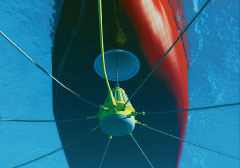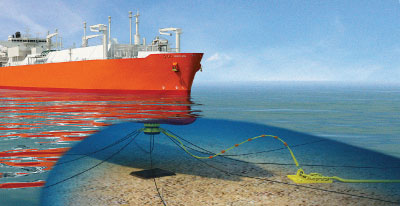 |
||||||||
Governor Approves Port Dolphin Offshore Natural Gas Terminal
By Mary Kelley Hoppe
 A new liquid natural gas (LNG) receiving port to be developed off the coast of Tampa Bay promises to provide a new source of clean-burning fuel for Florida. Governor Charlie Crist announced his approval of the project in September; construction is expected to begin in 2011 with the new terminal coming online in 2013.
A new liquid natural gas (LNG) receiving port to be developed off the coast of Tampa Bay promises to provide a new source of clean-burning fuel for Florida. Governor Charlie Crist announced his approval of the project in September; construction is expected to begin in 2011 with the new terminal coming online in 2013.
Port Dolphin Energy, a subsidiary of Norwegian-based international shipping company, Hoegh LNG, plans to construct the deepwater port 28 miles off the coast of Manatee County. LNG tankers arriving at the port would connect to a natural gas pipeline running from the offshore terminal to Port Manatee and then inland for four miles before connecting with the state’s natural gas pipeline grid. The LNG would be returned to a gaseous state aboard the specially designed shuttle and regasification vessels (SRVs) before being fed into the pipeline to serve customers throughout west central Florida.
“We are pleased with Gov. Crist’s decision to approve this very important project. When completed in 2013, Port Dolphin will be able to provide Florida utilities with another source of clean energy,” said Sveinung J. Stohle, president and chief executive officer of Hoegh LNG.
 Art courtesy of Hoegh LNG |
| Underwater buoys 28 miles off the coast of Manatee County will connect tankers to a pipeline bringing natural gas into Port Manatee. |
Hoegh currently operates a fleet of four liquefied natural gas carriers, with two SRVs on order. Beginning next year, the company will provide SRVs to the new Neptune deepwater LNG port in Massachusetts Bay off Boston, and is preparing to file for approval of another deepwater LNG receiving terminal to import natural gas to the UK’s west coast.
Tampa Bay’s offshore LNG receiving terminal will be the fourth such facility in the U.S. and the first in Florida waters. The project will consist of two submerged turret unloading and mooring buoys for receiving gas from Hoegh SRVs, a 42-mile offshore pipeline for transportation of natural gas from the offshore terminal to Port Manatee, and a 4-mile onshore pipeline to the Florida gas network.
None of the Port Dolphin project equipment will be above the water’s surface. Instead, the underwater buoys and related equipment will rest on the seafloor until ships arrive to offload their cargo.
 |
| The specially designed tankers that will serve Port Dolphin are known as Shuttle and Regasification Vessels or SRVs. After regasifying their liquid natural gas cargo aboard ship, the SRVs will offload the gas via an underwater buoy connecting to a submerged pipeline. |
The company estimates that the project will generate a direct economic impact to Manatee County and Port Manatee of $125 million over the next 20 years.
As Florida’s utilities move away from reliance on coal for production of electricity, demand for clean-burning natural gas has grown. Port Dolphin estimates that it will be able to supply natural gas to meet 15 percent of Florida’s needs. “The initial throughput would be 400 million cubic feet per day per vessel, with an average capacity of 800 billion cubic feet and peak capacity of 1200 million cubic feet,” said Wayne Hopkins, a spokesman for the company.
Local officials had inquired about the possibility of connecting the new offshore port to the existing Gulfstream Natural Gas pipeline, which transports natural gas from Alabama across the Gulf and into Florida at Port Manatee. However, that proved to be infeasible because Gulfstream’s pipeline has a fixed amount of capacity measured at 1 billion cubic feet of natural gas per day and almost all of this capacity is already in use. The Port Dolphin pipeline will provide an additional capacity of 1.2 billion cubic feet of natural gas per day to the region, enough to generate electricity for approximately 1 million homes.
By diversifying and expanding Florida’s supply of natural gas, the new supply is expected to improve the competitiveness of the state’s energy market and help moderate natural gas prices.
Saving sand for beach renourishment
Manatee County and the Town of Longboat Key had expressed concern that the original pipeline alignment, entering Tampa Bay near Anna Maria Island, would impact sand deposits designated for beach renourishment. The company twice altered the pipeline route to reduce those impacts.
“The loss of white sand resources associated with pipeline construction poses a very real economic hardship on beach communities that rely on beach renourishment for tourism and storm protection,” said Charlie Hunsicker, Manatee County’s director of natural resources.
While the final route avoids existing sand borrow areas, future sand deposits remain within the 400-foot buffers on either side of the pipeline. Before a compromise was reached, Hunsicker said local governments were seeking efforts to reroute the pipeline yet again. “When that proved not to be economical, it gave rise to the adage ‘move the sand, not the pipeline.’”
Under the terms of a final agreement, Port Dolphin will deposit $1 million in a state escrow account to reimburse Manatee County and the Town of Longboat Key for permitting of borrow areas within the pipeline corridor and another $10 million for the communities to harvest the sand prior to pipeline construction. The Florida Department of Environmental Protection has agreed to expedite permitting of these offshore sand borrow areas, cutting in half a process that typically takes two to three years to complete.
To replenish the beach at the southern end of Anna Maria Island, Manatee County had planned to harvest sand from a borrow area closer to shore. “Accessing the sand from the Port Dolphin project will allow us to leapfrog over that area and give it time to rest and refill so it will be more valuable in the future,” says Hunsicker.
“This project underscored the need for a public planning process to prepare for other pipelines that may come into the Tampa Bay area,” he says. “Without proper planning to site a corridor for pipes to come ashore, we end up with the possibility of preempting nearly all of the beach-quality sand available, not to mention the impacts to live bottom and reef communities offshore of Tampa Bay.
“These efforts have elevated white sand deposits in the Gulf of Mexico to the same status of protection afforded to live bottom and archeological resources,” added Hunsicker.
Environmental improvements part of agreement
Beyond compensating for sand in the pipeline corridor, Port Dolphin Energy agreed to a number of additional environmental requirements outlined in a Sept. 17 Memorandum of Agreement with the state. The company will spend up to $24.4 million to outfit each of its SRVs with technologies aimed at reducing environmental impacts. A closed loop regasification system and comprehensive ballast and cooling water system will minimize seawater intake and velocity, while modified dual-fuel engines, low NOx burners and catalytic reduction systems control emissions of nitrogen oxides. Additionally, the company will provide:
- $8.5 million for a study to assess the deepwater port’s operational water intake on marine fisheries and collect field data, in cooperation with state and federal agencies,
- $3 million to support activities associated with the development of renewable energy, and
- $500,000 for cultural, marine education and recreational activities in local communities adjacent to the project.
Port Dolphin also will be required to develop and implement a plan to mitigate for impacts and monitor the recovery of hard and live-bottom habitats affected by the construction of the port and pipeline.
Gov. Crist’s support for the project clears the way for a permitting process that is expected to be complete in 2010, with construction scheduled to begin in 2011.
| About the technology The advent of new technologies for storing and transporting liquid natural gas (LNG) has led to projects like Port Dolphin, which will be the fourth LNG deepwater port in the U.S. when completed in 2013. The project includes a submerged natural gas receiving port 28 miles off the coast of Manatee County and an undersea natural gas pipeline connecting to the shore at Port Manatee. The deepwater port will consist of two buoys on risers that will be installed about three miles apart in 100 feet of water. The buoys and related equipment will rest on the seafloor until ships arrive to offload their natural gas cargo. If a hurricane were heading in the direction of the buoys, the LNG transport ships would simply sail away from the area and the buoys would be dropped to the seafloor, where they would be safe from high winds or waves. The vessels that will serve Port Dolphin are known as Shuttle and Regasification Vessels (SRVs). These highly sophisticated ships are designed to carry LNG long distances and have the capability of heating and regasifying the LNG prior to offloading the gas for transportation by pipeline to its connection points onshore. Once a ship is moored at the port, LNG is pumped from the tanks and sent to regasification units on deck. Pressure is boosted by large cryogenic LNG pumps. Steam generated by auxiliary boilers in the vessel's main engine room produces the heat necessary to regasify the LNG. Regasification and transfer of the gas can take anywhere from four to eight days. Regasified LNG is discharged via a trunk in the forward part of the vessel which houses a turret buoy mating cone and swivel system that connects to the riser and submerged pipeline. The two separate buoys will ensure continuous send-out by overlap between arriving and departing SRVs. About 50 to 70 SRVs are expected to dock at Port Dolphin each year. |
